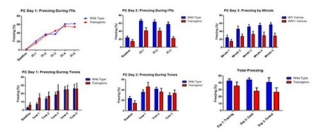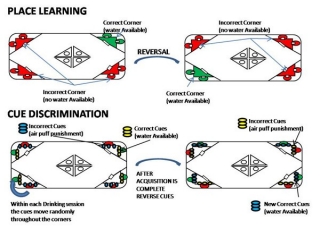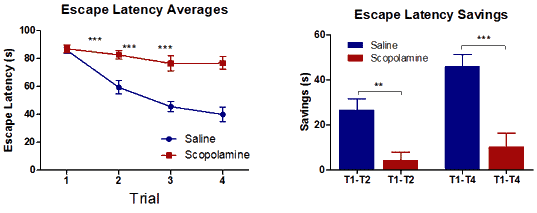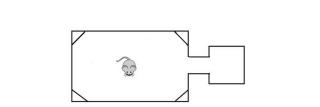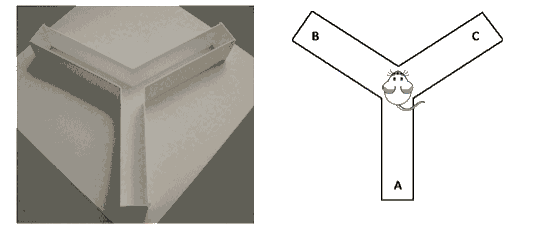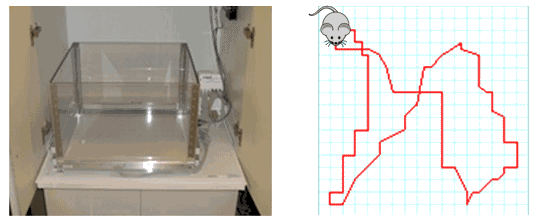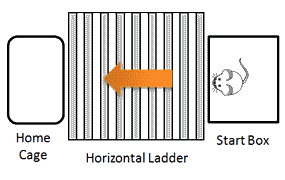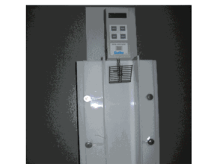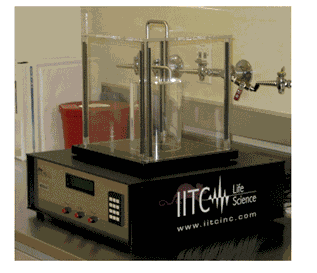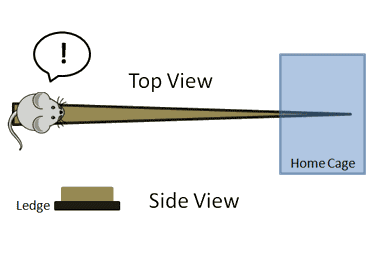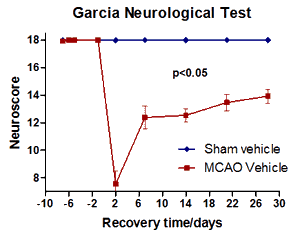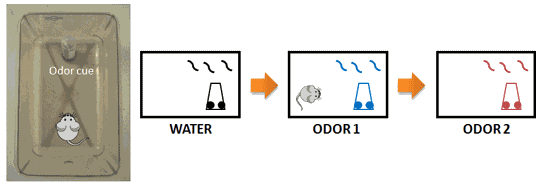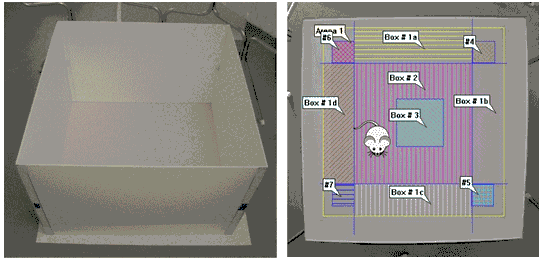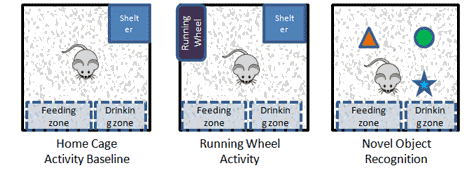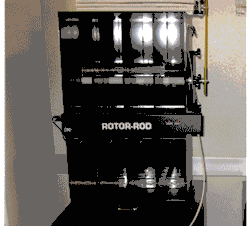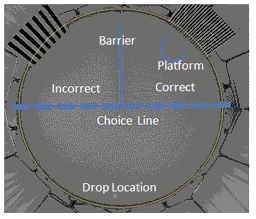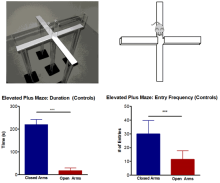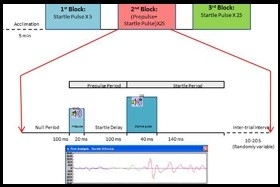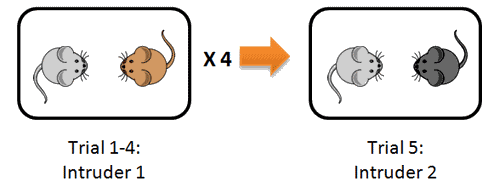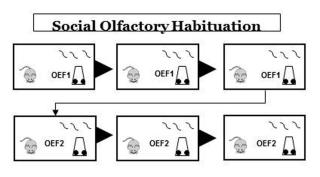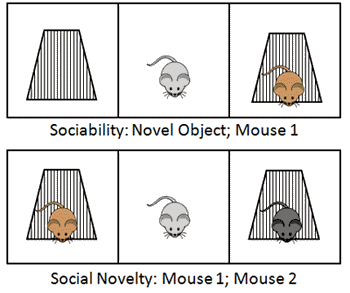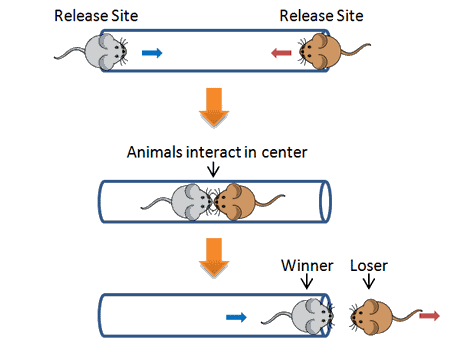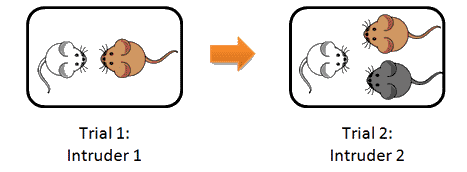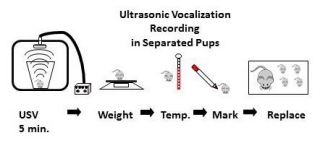We offer a wide range of behavioral neuroscience models in the following categories:
- Learning and Memory Tests
- Sensory and Motor Tests
- Experimental Psychiatric Tests
- Social Interaction Tests
Learning and Memory Tests
2-Object Novel Object Recognition
The Novel Object Recognition (NOR) task is used to evaluate cognition, particularly recognition memory, in rodent models of CNS disorders. This test is based on the spontaneous tendency of rodents to spend more time exploring a novel object than a familiar one. The choice to explore the novel object reflects the use of learning and recognition memory.
Delayed Match to Place Water Maze
The Delayed Match to Place protocol is designed to test spatial memory and working memory by observing and recording escape latency, thigmotaxis duration, distance moved, and velocity during the time spent in the water maze tank. Tempera paint is added to the water until it becomes opaque and a hidden platform with a diameter that is 1/10 the diameter of the tank is placed about 1cm below the water’s surface. Three quarters of the water tank is surrounded by privacy blinds with at least three 2-Dimensional and/or 3-Dimensional visual cues.
Fear Conditioning
Fear Conditioning (FC) is a type of associative learning task in which mice learn to associate a particular neutral Conditional Stimulus (CS)—often a tone—with an aversive Unconditional Stimulus (US)—often a mild electrical foot shock—and show a Conditional Response (CR)—often as freezing. After repeated pairings of CS and US, the animal learns to fear both the tone and training context. FC is learned rapidly, and after one conditioning session, a very stable and long-lasting behavioral change is produced which is useful for neurobehavioral, genetic, and pharmacological studies.
Intellicage Place Learning and Cue Discrimination Experiments
The Intellicage is an automated testing chamber used to test cognitive ability of socially housed mice. The Intellicage allows for sensitive behavioral testing of cognitive, sensorimotor, and locomotor ability. Automated Chambers have several advantages to classical test design. It allows for high-throughput testing in a socially enriched environment, with up to 15 animals tested in a chamber. Also, the computer software conducts all tests without any experimenter manipulation required. Two major benefits of automated chambers are: (1) it saves the experimenter time, and (2) it minimizes the handling of the animals.
Modified Barnes Maze Test
Based on the Delayed Match-to-Place (DMP) experiment conducted in a standard water maze tank, the Modified Barnes Maze test assesses cognitive deficits in rodent models of CNS disorders. The Modified Barnes Maze is thought to measure similar learning abilities as the DMP without forcing the subjects to perform a task under unnatural conditions, e.g. swimming in water. Testing occurs on a circular platform with numerous escape holes ringed around the center of the platform. Bright overhead lighting creates an aversive stimulus, encouraging the animal to seek out the Target Escape Hole, which is attached to an escape tube, and escape from the light. Visual cues placed around the maze act as spatial cues.
Morris Water Maze
The Morris Water Maze (MWM) is designed to test spatial memory and long-term memory by observing and recording escape latency, thigmotaxis duration, distance moved, and velocity during the time spent in the MWM water tank.
Object Location Memory Task
The Object-Location Memory task assesses cognition—specifically spatial memory and discrimination—in rodent models of CNS disorders. This test is based on the spontaneous tendency of rodents to spend more time exploring a novel object than a familiar object, and also to recognize when an object has been relocated. Testing occurs in an open field arena, to which the animals are first habituated. The next day, four objects of similar material but different shapes are introduced to the arena. They are spaced roughly equidistant from each other with space in the middle for introducing the subject.
Passive Avoidance Task
The Passive Avoidance Task is a fear-aggravated test used to evaluate learning and memory in rodent models of CNS disorders. In this test, subjects learn to avoid an environment in which an aversive stimulus (such as a foot-shock) was previously delivered.
Satellite Box Exploration in the Intellicage
The Intellicage is an automated testing chamber used to test cognitive cognitive ability in socially housed mice. By attaching a satellite box to the chamber, an experimenter can also study exploratory behavior in a novel environment.
T Maze Spontaneous Alternation Test
T Maze Spontaneous Alternation is a behavioral test for measuring exploratory behavior in animals, especially rodent models for CNS disorders. This test is based on the willingness of rodents to explore a new environment—i.e., they prefer to visit a new arm of the maze rather than a familiar arm. Many parts of the brain—including the hippocampus, septum, basal forebrain, and prefrontal cortex—are involved in this task.
Y Maze Spontaneous Alternation Test
Y Maze Spontaneous Alternation is a behavioral test for measuring the willingness of rodents to explore new environments. Rodents typically prefer to investigate a new arm of the maze rather than returning to one that was previously visited. Many parts of the brain—including the hippocampus, septum, basal forebrain, and prefrontal cortex—are involved in this task.
Sensory and Motor Tests
Activity Chamber
The Activity Chamber is a simple assessment test used to determine general activity levels, gross locomotion activity, and exploration habits in rodent models of CNS disorders. Assessment takes place in a square arena mounted with three planes of infrared detectors within a specially designed sound-attenuating chamber.
Basket Test
The Basket test is useful in assessing motor coordination and sensorimotor deficits in rodent models of CNS disorders. An animal is placed in the center of the basket and the basket is inverted. The animal is allowed to climb down the walls of the wire basket into its home cage.
Cylinder Test
The Cylinder test is designed to evaluate locomotor asymmetry in rodent models of CNS disorders. As the animal moves within an open-top, clear plastic cylinder, its forelimb activity while rearing against the wall of the arena is recorded. Forelimb use is defined by the placement of the whole palm on the wall of the arena, which indicates its use for body support.
Foot Fault Test
The Foot Fault test is a tool for assessing locomotor function in rodent models of CNS disorders. Subjects are placed on an elevated horizontal ladder and trained to cross the device. Video scoring or sensors record paws slipping along the steps of the ladder as the animal crosses. Paw misplacements and the ambulatory time are recorded for each run of the test; a total of four runs are recorded for each animal.
Grip Strength
The Grip Strength test is used to evaluate motor function and deficit in rodent models of CNS disorders. The animal’s paws are placed on a wire grid, which the animal will naturally hold on to while its tail is gently pulled backwards.
Hot Plate
The Hot Plate test is a common sensorimotor task that measures thermal nociception in rodent models of CNS disorders. This test measures the nociceptive responses of mice when they are placed on a warmed metal plate either at a standard, constant temperature or at slowly increasing temperature, starting from non-noxious levels to a standard, constant temperature.
Ledged Beam Test
The Ledged Beam test is used to assess sensorimotor deficits in rodent models of CNS disorders. Subjects walk across an elevated beam that gradually narrows in width as they approach their home cage. The beam features a ledge that catches the animal’s paw if it slips off the edge. Misplacements of the paw off the beam are video recorded and scored.
Neurological Testing
Two main neurological tests are used to assess motor and behavioral deficits in rat models of CNS disorders. Both the Garcia test and the 28-point Neuroscore test involve a battery of motor tests, ranging from simple observation to traversing a horizontal bar. These tests are well-suited for assessing neurological damage due to ischemia and the effects of novel chemical entities on motor performance.
Olfactory Test
The Olfactory Test is a sensory assay used to measure the olfactory ability, degree of social interest, and perception of social novelty in rodent models of CNS disorders. The nonsocial olfactory test employs water and synthetic odorants, while the social olfactory test uses water and urine samples from other animals. Cotton swabs dipped in odorant solution are placed in centrifuge tubes with holes drilled around the base at regular intervals, thus preventing the animal from chewing or sitting on the cotton swab.
Open Field
The Open Field task is a simple sensorimotor test used to determine general activity levels, gross locomotor activity, and exploration habits in rodent models of CNS disorders. Assessment takes place in a square, white Plexiglas box. The animal is placed in the arena and allowed to freely move about for 10 minutes while being recorded by an overhead camera. The footage is then analyzed by an automated tracking system.
Phenotyper (Automated Behavior Testing)
The Phenotyper is an observation system that uses home-cage testing to assess behavioral activity in rodent models of CNS disorders within a controlled environment. The advantages of home-cage testing include minimal handling, long-term recording, and automated analyses that are useful for behavioral and pharmacological testing.
Rotor-Rod
Rotor-Rod is a test used to assess sensorimotor coordination and motor learning in rodent models of CNS disorders. The subjects are placed on a rotating rod with either constant rotation or a steady acceleration; the latency to fall is recorded, where the subjects fall safely 9" below the rotating rod. During training, subjects learn to balance on a stationary rod, then on a rod constantly rotating at 10 rpm.
Vibrissae-Evoked Forelimb Placing
The vibrissae-evoked forelimb placing test (also known as the paw whisker test) is useful for assessing asymmetry in the sensorimotor cortex and striatum. The experimenter holds the animal so that all four limbs hang freely. The vibrissae are stimulated by brushing each side against the edge of a table. This elicits a same-side forelimb response to place the paw on the table top. The rat is allowed ten trials on each side and the percent of successful placements is recorded.
Visual Acuity Test
The Visual Acuity Test is used to assess visual discrimination and acuity in rodent models of CNS disorders. In this test, mice swim in a water tank with a clear plastic barrier and two cue cards of variable black and white gratings.
Wire Hang Test
The Wire Hang test seeks to evaluate motor function and deficit in rodent models of CNS disorders. The test begins with the animal hanging from an elevated wire cage top. The animal is placed on the cage top, which is then inverted and suspended above the home cage; the latency to when the animal falls is recorded.
Experimental Psychiatric Tests
Elevated Plus Maze
The Elevated Plus Maze (EPM) test is used to assess anxiety-related behavior in rodent models of CNS disorders. The EPM apparatus consists of a "+"-shaped maze elevated above the floor with two oppositely positioned closed arms, two oppositely positioned open arms, and a center area. As subjects freely explore the maze, their behavior is recorded by means of a video camera mounted above the maze and analyzed using a video tracking system.
Prepulse Inhibition and Startle Reflex Test
Prepulse inhibition (PPI), also termed as startle reduction or reflex modification, is a phenomenon in which a weak stimulus (prepulse) can suppress the startle response to a subsequent stronger startle stimulus (pulse).
Conditioned Place Preference
Coming soon...
Social Interaction Tests
Five-Trial Social Memory Test
The Five-Trial Social Memory Test assesses cognition—i.e., the ability to recognize novel vs. familiar animals, in rodent models of CNS disorders. Over the course of multiple exposures, rodents will become habituated to intruders and no longer find them as interesting as a completely novel intruder.
Olfactory Habituation and Dishabituation
This experiment measures olfaction, memory, and social interest. Mice are first presented with three nonsocial odor cues. Each odor is given three times in three consecutive trials. Mice should become habituated to a familiar smell, and spend less time investigating the smell over each trial if they have normal olfaction and memory.
Three-Chamber Sociability and Social Novelty Test
The Three-Chamber test assesses cognition in the form of general sociability and interest in social novelty in rodent models of CNS disorders. Rodents normally prefer to spend more time with another rodent (sociability) and will investigate a novel intruder more so than a familiar one (social novelty). Based on these inclinations, the Three Chamber Test can help identify rodents with deficits in sociability and/or social novelty.
Tube Dominance Test
The Tube Dominance test assesses cognition in rodent models of CNS disorders, particularly social dominance through the measurement of aggression. Subjects of different genotypes are released into opposite ends of a clear, narrow tube. The animals interact in the middle of the tube; the more dominant animal will show greater aggression and force its opponent out of the tube. When one animal has all four paws out of the tube, it is declared the loser while the animal remaining inside the tube is the winner, ending the match.
Two-Trial Social Memory Test
The Two-Trial Social Memory test assesses cognition—namely, the ability to recognize novel vs. familiar animals, in rodent models of CNS disorders. Over the course of multiple exposures, rodents will become habituated to an intruder and no longer find them as interesting as a completely novel intruder.
Ultrasonic Vocalization Test
Rodent communication includes calls in the ultrasonic range. Mice pups will start emitting ultrasonic vocalizations (USV) shortly after birth. These calls elicit pup retrieval by the dam, maternal licking, and crouching behavior.


